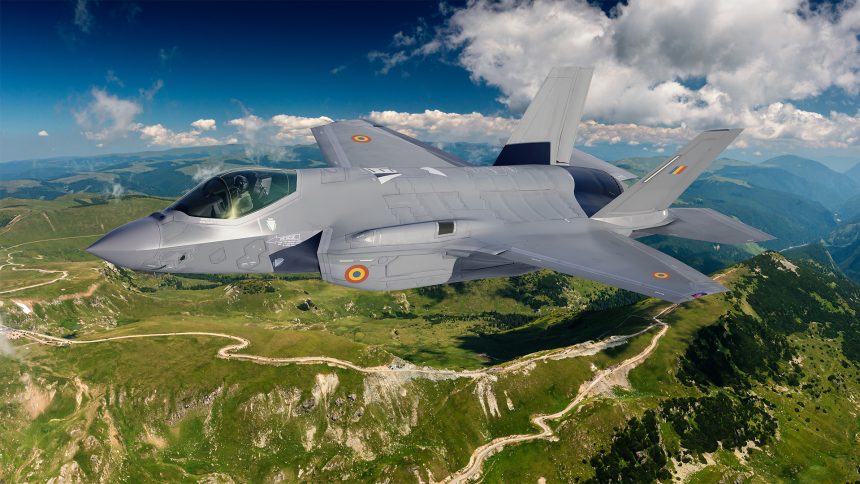Romania becomes the 20th nation to join the F-35 program.
On Nov. 21, 2024, Romania became a part of the Lockheed Martin F-35A Lightning II program by signing a LoA (Letter of Acceptance) to acquire 32 airframes of the fifth generation stealth fighter, through a U.S. government FMS (Foreign Military Sale). The U.S. State Department in September had approved the $7.2 billion deal, which the Romanian Senate recently voted to pass the legislation ratifying the purchase of the aircraft.
The DSCA (Defense Security Cooperation Agency) notification to Congress included 33 Pratt & Whitney F135-PW-100, where 32 are installed and one is a spare unit. Other equipment includes communications, electronics, avionics, targeting, encryption, cryptographic suites, missiles, ammunition, support, maintenance, testing equipment, spares, accessories, electronic warfare, software development, laboratory and U.S. logistics support.
In the latest contract signing ceremony held in the presence of the U.S. Ambassador to Romania Kathleen Kavalec, the diplomat said that the “advanced fighter jets” would be a “key step in the ongoing modernization of the Romanian Armed Forces and will contribute significantly to the long-term defense of the NATO Alliance and our collective security.” The F-35 purchase is a part of Bucharest spending 2.5% of its GDP on defense.
F-35: Built for Romania.
Romania has signed an LOA for 32 F-35s—the most advanced, connected and capable fighter jets in the world. pic.twitter.com/bxvUkDpwEt
— F-35 Lightning II (@thef35) November 21, 2024
F-16s and contribution to NATO defense
Romania’s acquisition of the F-35 will strengthen NATO’s eastern flank especially in the Black Sea region, amid heightened military confrontation with Russia. Kavalec also mentioned the Romanian Air Force having shown “extraordinary commitment to modernize legacy MiG aircraft with F-16 fighters in close cooperation with the U.S. and Allies such as Portugal and Norway.”
In 2013, Romania signed a contract with Portugal for 12 F-16 A/B Block 15 MLU jets, and another deal in 2019 for another five of the same jet and variant, which were delivered by March 2021, operating 17 airframes of the F-16 A/B Block 15 MLU version. In November 2023, Scramble reported that Romania also received the first nine of the 32 second-hand F-16AM/BMs from Norway to be flown by the FAR (Fortele Aeriene ale Romanei/Romanian Air Force).
It has contributed to the war effort in Ukraine by inaugurating the EFTC (European F-16 Training Center/Fetești Training Centre), as a collaborative effort with the Netherlands and Lockheed Martin. With a fleet of 14 Dutch F-16s, of which seven were dual-seat and the rest being single seaters, the first seven Romanian pilots graduated on the jets in July 2024, receiving their “mission-ready” status. These pilots previously flew the Soviet-era MiG-21 jets.

For transitioning to the F-16s, the pilots underwent 200 hours of theoretical, 500 hours of simulator training and 400 hours of actual flying to make them “fully prepared for all types of missions,” Euronews quoted Gabriel Nicușor Anghel, adviser to the Romanian Minister of Defence. Kavalec said in that report that the Romanian pilots also learnt to use “team intelligence while executing modern air-to-air and air-to-ground flight tactics.”
In September, Ukrainian pilots also began training at the EFTC, marking Romania’s emergence as an international hub for F-16 training. The center also has the involvement of subcontractors like Daedalus Aviation Group, Draken International, GFD, ILIAS Solutions, and BGI, LLC.
First batch of F-16 fighter jets procured from #Norway arrived in #Romania. This will help us secure our skies. Today, almost 20 years since we became a NATO Ally, we are safer and are getting stronger. pic.twitter.com/UwSrnobdTi
— Dan Neculaescu (@DanNeculaescu) December 2, 2023
Transition to F-35s
Commenting in the backdrop of the F-35 purchase, Kavalec said how the F-16s, while “significantly” enhancing “Romania’s air defense” and “enabling” it for a “more prominent role in NATO’s Air Policing missions,” also “lays the critical foundation for Romania’s ultimate transition to the F-35 fighter jet in the 2030s.”
The transition not only enhances “Alliance interoperability” but also provides “the most advanced capability to survive in a cutting-edge threat environment in the years ahead.” The F-35’s advanced sensors, stealth capabilities, and network-centric warfare architecture will enable Romania to operate more effectively in a rapidly changing security environment.
The U.K. Italy, the Netherlands, Denmark and Norway being current active users of the fifth generation jet. Belgium and Poland are on their way to receive the fighters too. After Germany and Finland, Romania has become the “twentieth member of the F-35 global alliance,” the jet’s developer Lockheed Martin said in a release. Israel, Australia, South Korea and Japan are the other non-European users of the jet.
Romanian F-16s intercepted russian fighters that flew into the NATO zone
Romanian pilots accompanied them to the exit from the area of responsibility of the Alliance.
Photos – Air Force of Romania@24tvua pic.twitter.com/vctk90a8aI
— Mariia Kramarenko (@KramarenkoMari3) April 8, 2023
The presence of the F-35 in the fleet of all NATO countries bordering Russia is a credible threat to both the RuAF (Russian Aerospace Forces) and Russian Ground Forces. Tactical networking, coordination and teaming tactics between Allied F-35s and between F-35s and other Western Gen. 4 and Gen. 4.5 fighters represents the only aerial domain where the West matches Russia, if not on the ground.









